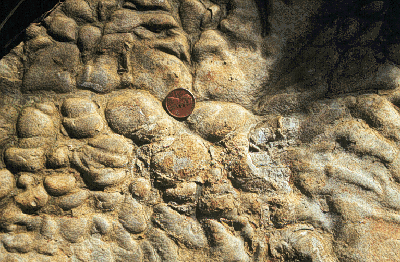
Load casts:
http://www.geo.duke.edu/ss/ss.htm
5) Glide surfaces:These erosional features are observed within thinly bedded mud. They are interpreted to form as a result of large-scale slides or slumps and to have little internal deformation.They are normally recognized by their sharp contacts.
Glide plane identified in outcrop:
(Brown and Loucks, 1993)
6) Mud Mounds:Mounds of skeletal debris and lime mud enclosed in beds of dark laminated sandy beds, or shales.7) Medium-scale cross-bedding:Cross beds up to ½ mm thick, caused by scour and fill of megaripples formed by moderately strong currents.
Cross bedding:
http://www.geo.duke.edu/ss/ss.htm
8) Injection Dikes:beds that cut vertically through massive or normally bedded strata, filled by material squeezed up from below in response to loading of the substrate by the overlying carbonate mass.9) Filled fissures:Discordant sediment filling fissures that cut across normally, bedded strata. These fissures may have opened in response to slumping and/or tectonic activity. The sediment fill is normally sand sized or coarser material.10) Nodular bedding:Layers that consist of fine beds grading to loosely packed nodular bodies of rock in matrix of like or unlike character.
Nodular chert: http://www.geo.duke.edu/ss/ss.htm 11) Sedimentary Boudinage:These features form as the result of differential compaction of patchy deposits of shale and carbonate. These deposits form irregular, closely spaced structures caused by a disruption of layers by stretching and flowage.
Boudin Structures
http://www.geo.duke.edu/ss/ss.htm
12) Bioturbation and Burrows:Mixing of sediment by burrowing organisms. Preserved as tubular ichnofacies whose margins may be emphasized through dolomitization.
Deposit Homogenized through bioturbation:
http://www.geo.duke.edu/ss/ss.htm
Intensive burrowing:http://www.geo.duke.edu/ss/ss.htm
References and Sources:
Bates, R.L., Jackson, J.A. Dictionary of Geological Terms. Anchor Books, New York : 1984.
Brown, A.A., Loucks, R.G. Influence of Sediment Type and Depositional Processes on stratal Patterns in the Permian basin-Margin Lamar limestone, McKittrick Canyon, Texas in carbonate sequence stratigraphy:Recent Developments and Applications. Ed. Loucks, R.G. and Sarg, J.F. AAPG Memoir 57, Tulsa: 1993. p.145.
Coniglio, M., Dix, G.R. carbonate Slopes in Facies Models: Response to Sea Level Change. Ed. R.G. Walker and N. P. James. Geological Association of Canada, St.Johns: 1992. pp 349-373.
Scholle, P.A., Bebout, D.G., Moore, C.H., (Eds.). carbonate Depositional Environments. AAPG Memoir 33, Tulsa: 1983.
Wilson, J.L. carbonate Facies in Geologic History. Springer-Verlag, New York: 1975.